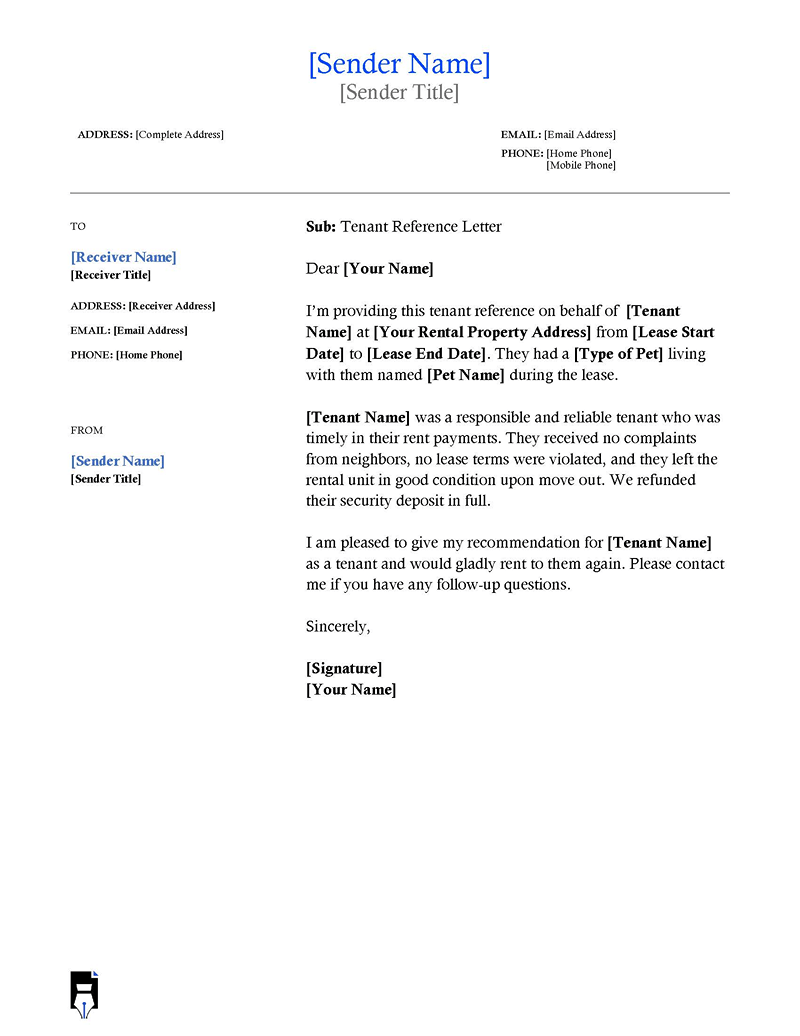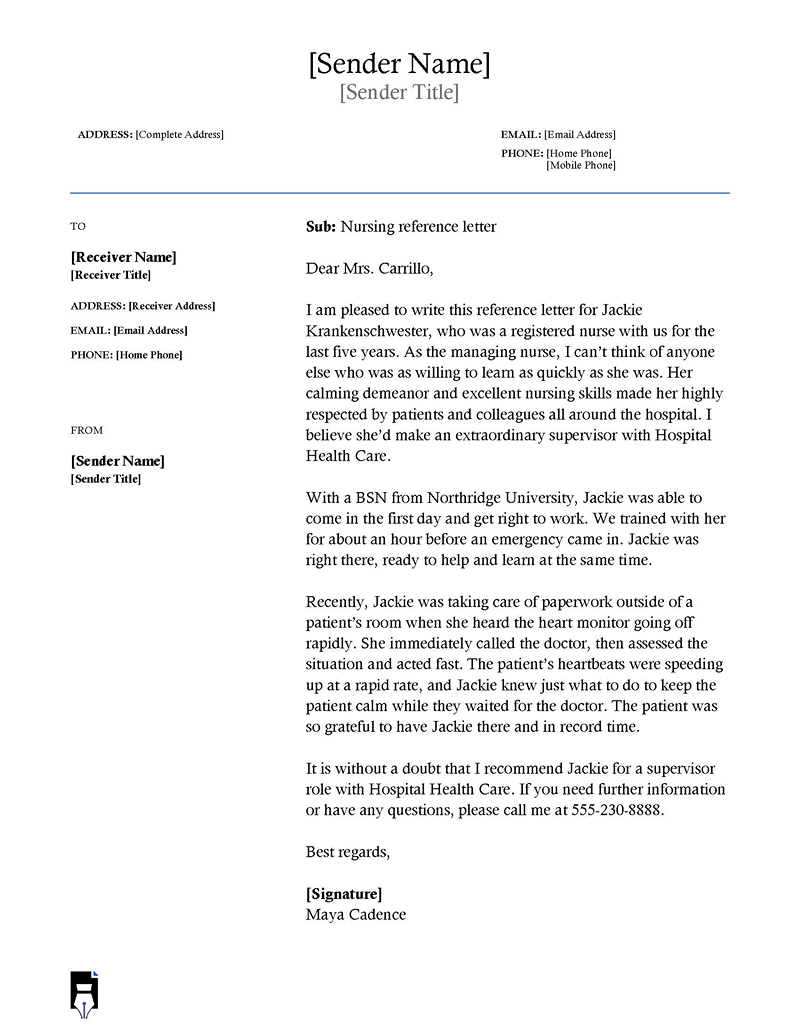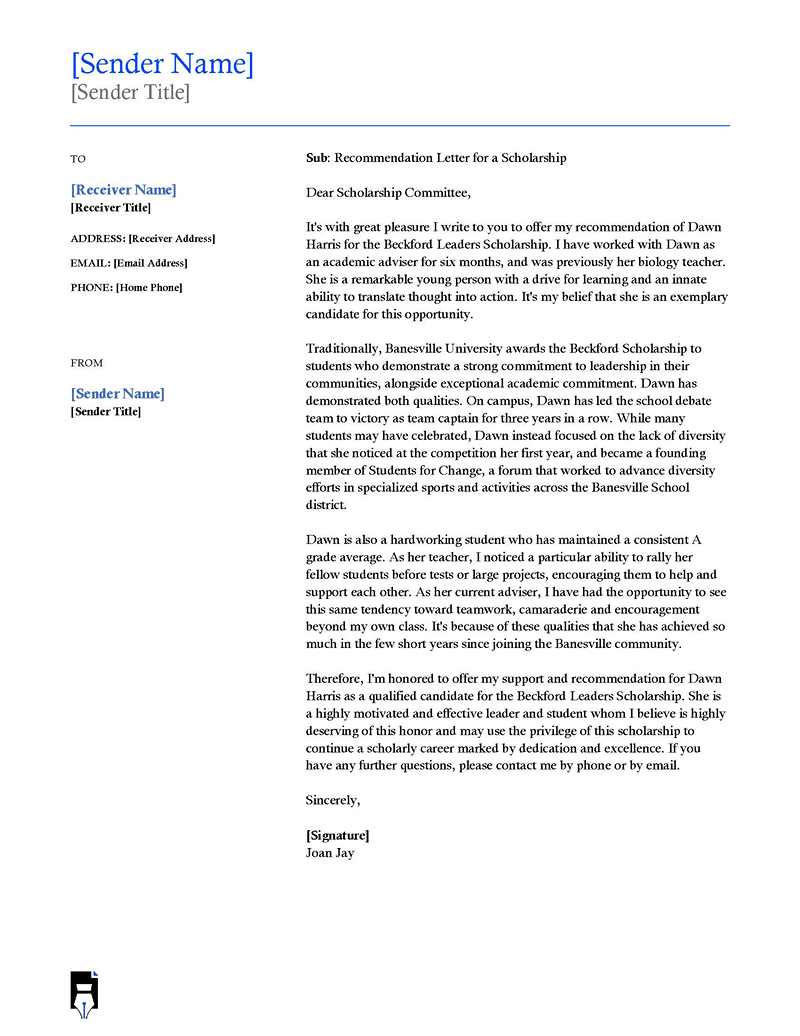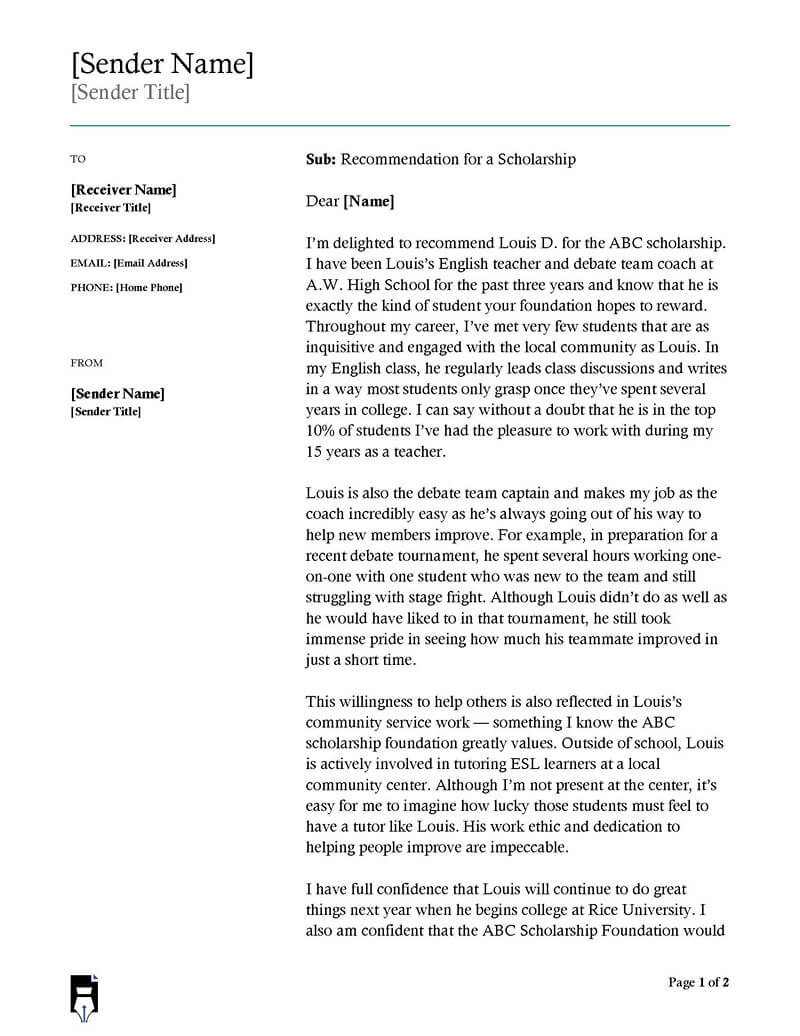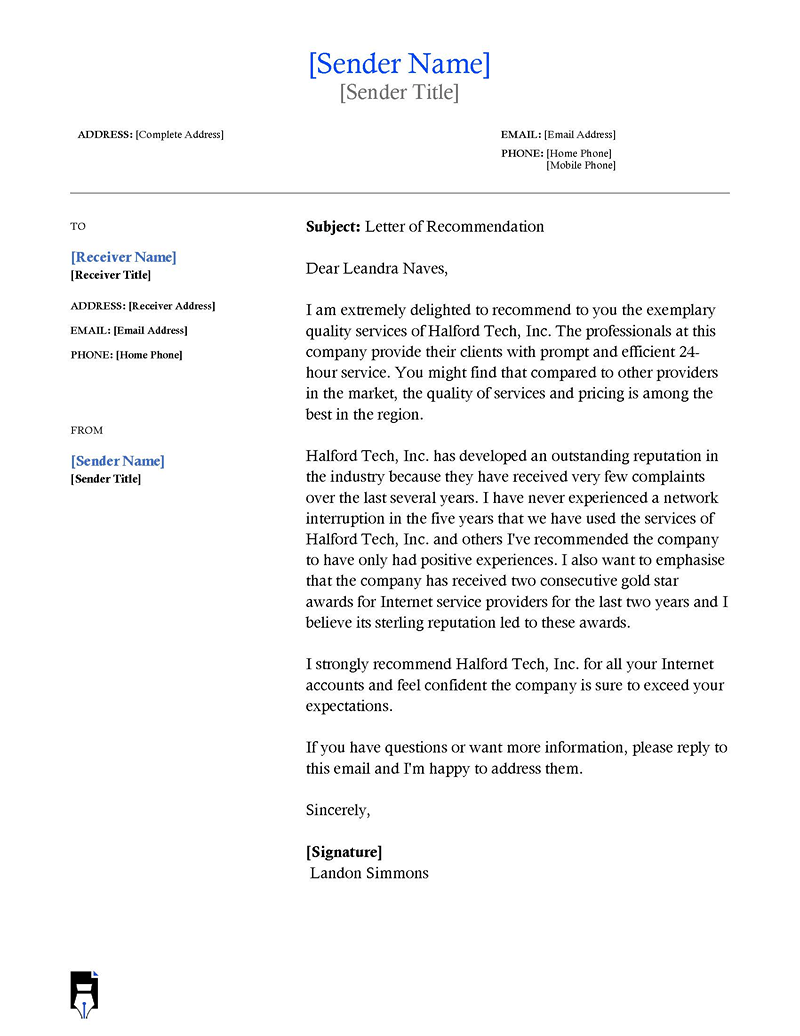A reference letter is typically written to vouch for an individual’s skills and expertise in a particular field. Traditionally, these letters were used for job and school applications. However, they can be used when applying for tenancy, loans, scholarships, visas, etc. Generally, the letter must be written by someone who knows the recommended person or their work well enough. Examples of referees are lecturers, department heads, work supervisors, work colleagues, landlords, individuals in supervisory roles, or directly interacting with the recommended candidate. Since they are third-party accounts of a candidate’s suitability, they carry much weight in the application.
A reference letter will contain different information based on who is being recommended and its purpose. There lies a difference between a rental and a scholarship recommendation letter. However, it can focus on the candidate’s character, knowledge, skills/abilities, work history, rental history, or financial capabilities depending on the situation. It should be formally formatted and use a professional tone. This can be achieved by obtaining a free template and reviewing the different elements of an effective and professional reference letter.
Free Templates
Below are the reference letter templates:
This article discusses the different types of reference letters. Also, it is a guide on the key elements to include and the format to use when crafting such letters to suit the application.
Note: You do not always have to accept every request to write a reference letter. You can politely decline if you feel like you cannot write a strong reference, whether because you are not close or familiar with the candidate or cannot recommend them due to their inadequacies in character or expertise.
Purpose of a Reference Letter: Supporting Your Goals and Needs
A reference letter has multiple purposes in any application process. It is a third-party account of the qualities and skills of a candidate. The letter is evidenced-based and provides examples of first-hand experience regarding who the applicant is as a person. This way, the reader can evaluate the skills and expertise the applicant offers to the organization if selected.
The reference letter supports the information and claims made in other application documents such as resumes, cover letters, proposals, etc. It also outlines unbiased facts regarding the applicant’s value. Most employers or acceptance committee value reference letters as authors are expected to be informed and trustworthy to comment on the candidate’s character or competencies. A well-written strong reference greatly increases an application’s chances of succeeding.
How To Write a Reference Letter (Step-by-Step Guide)
It is imperative to know what to include in a reference letter, but more importantly, you must know how to combine the information into a comprehensive recommendation. Its contents must be objective and unbiased, and its structure must be rational to convey your ideas efficiently.
Below are steps you should follow when crafting such a letter:
Step 1: Introduce yourself and the candidate
Immediately after the salutation, the first step is to let the reader know who you are. The recipient wants to know your name, the applicant’s name, your relationship with the applicant, and the letter’s purpose. The closer your relationship with a candidate, the stronger your recommendation will be. So, provide some background information such as the affiliated company, job title, how long you have known the applicant, and other relevant details.
Also, your social status, e.g., sheriff, pastor, professor, etc., and profession can sometimes increase the letter’s credibility. Organizations will want to know that you are a credible and trustworthy source hence the need to introduce yourself.
Below is a sample of a comprehensive introduction:
I am James Hunter, a district attorney at Evermore County, NC. This letter is a recommendation for Beret Jackson, a community member. I have known Jackson since he was a teenager when his parents moved to our town 13 years ago. I am a mentor and great friend to him and his family.
Note: If the reference is made via email, the recommended candidate’s name should be included in the subject line—for example, Reference Letter for John Doe.
Step 2: State the purpose of the letter
Next, indicate the skills or qualities you will discuss depending on the type of application at hand and the letter’s purpose. You should be selective about the skills and qualities you include because you have to validate them in the next section of the letter. Also, the skills and traits must be relevant to the application. You can ask the applicant which skills and qualities would strengthen their application before deciding which ones to include. This information can be relayed in a sentence to conclude the first paragraph.
For example:
I have seen Mercy actively involved in voluntary community work through the years. She has proved to be a leader and role model who is organized, empathic and ambitious.
Step 3: Provide supporting examples
In the next step, you must provide examples of how the applicant has demonstrated the listed skills and qualities. In this section, you should refer to the observations, assessments, and experience to show how the applicant possesses the mentioned skills and traits. Choose examples that substantiate at least two or more skills and qualities to avoid writing a long letter. This section should be detailed enough to enrich the reference letter.
For example:
At 18, Mercy was the youngest person to have volunteered for an assistant programs manager and coordinator position at Hawks Eye Community Center. She excelled in this position and deputized the manager in over 10 programs that were run seamlessly. Programs were completed before deadlines due to her organizational skills, discipline, and ability to mobilize people to commit to work. Since her bold step to volunteer at such a young age, we have had other teenagers imitate her and take up more senior positions. This has guaranteed the continuity of the cause as more youths continue to join. Mercy vows to push the need for community-based help centers through legislation. This goal motivated her to join your college to pursue project planning and community development.
Step 4: Include a summary
Then, you should summarize your recommendation in the third last paragraph. You should be assertive when giving your statement of recommendation. You can use particular statements like “highly recommend” or “recommend without hesitation” to emphasize your stance.
For example:
Without a doubt, I recommend Mercy’s Johnson for the St. Luke University of Charleston (2023) scholarship. She can be a competitive student and a valuable member of your community as she has been in our local town.
Step 5: Write your concluding paragraph
The second last section of the reference letter is the conclusion. In two or three sentences, you are required to end the recommendation on a positive note. You can reiterate the skills and traits mentioned in the body of the letter. Also, if you want to state how exceptional the applicant is compared to others, you can do so in this section.
Below is a sample of a conclusion:
Mercy is a naturally born leader who can be a great legislator in the future. Her exceptional performance at the community center has not been matched since she left 2 years ago. She will be an asset and a worthy alum if accepted at your institution.
Step 6: Invite follow-up questions
Lastly, you should invite the reader to contact you should they have any concerns. Be sure to include the contact information they can use. If there are limitations that you want to impose on any future communication, such as limiting calls during working hours or specific days, you should state them in this section.
For example:
I am available to answer any questions you may have regarding my recommendation. My phone number is (0002) 88878-2222, and my email is [email protected].
Reference Letter Template
My name is [your name], a [profession]. I am writing this letter in reference to [name of applicant]. I was his/her [relationship with the applicant] for [how long you have known the applicant]. I would like to recommend [applicant’s name] for [what the applicant is applying for]. He/she is a [enlist a few relevant skills or qualities to be discussed in the body section].
Over the years, [applicant’s name] has been dedicated [mention an area the applicant has excelled in]. I witnessed him/her [state noteworthy experiences or events demonstrating the skills mentioned in the introductory paragraph].
I highly recommend [applicant’s name] for [type of application you recommend, e.g., employment, scholarship awarding, entry acceptance, tenancy, etc.]
With the skills that [applicant] possesses, he would be an invaluable addition to your team. His/her [reiterate the applicant’s skills and qualities mentioned in the letter].
Kindly do not hesitate to contact me for any inquiries. My contacts are; [phone number] and [email address].
Types of Reference Letters
You can consult multiple samples of reference letters depending on the type of application in question or what is requested. Each type focuses on distinct aspects of the applicant to present them as more suitable for the positions they are applying for.
The types are as follows:
Character reference letter
A character recommendation focuses on the candidate’s personality and values. Character reference letter should give a descriptive overview of the kind of person the candidate is beyond their professional qualifications. Such a letter should focus on the positive qualities of the candidate. Ideally, this letter should be written by someone close to the candidate, such as a friend, relative, etc.
Reference letter for a friend
This letter is based on information derived from the friendship between the referee and the candidate. However, it should be unbiased and objectively assess the candidate’s qualities. This type of letter will normally not focus on the candidate’s professional qualifications. However, if the writer has interacted professionally with the applicant, they can include their skills and abilities.
Personal reference letter
A personal recommendation is written to showcase a candidate’s character and personality. These aspects can be shown by showcasing the applicant’s soft skills. Such a letter is best written by someone who knows the applicant outside their work, for example, a teacher, pastor, guidance counselor, colleague, or club leader. Personal references are often used when candidates have little professional experience or make large purchases such as a house.
Character reference letter for court
This recommendation is submitted to the court on a defendant’s behalf to persuade the judge to be lenient when giving the sentence or penalty. The letter must state who the writer is, their relationship with the accused, knowledge of the charges, any insights on major current or past events in the person’s life, and the comments on their character. The defendant or their lawyer should submit it to the court before the hearing date.
Employment reference letter
This letter is submitted along with a person’s job application documents, such as a resume and cover letter. It outlines the applicant’s value as an excellent employee in an effort to persuade the recruiter to give them a chance to work for them. This letter focuses on the applicant’s work ethic, skills, experience, and noteworthy achievements. HR representatives, managers, supervisors, and mentors often write such a recommendation.
Employee reference letter
An employer must write recommendation letters for their current and previous employees. Since they can write the letter for multiple uses, they should ask the employee to specify the type of application so that they can tailor the letter appropriately. It is important to clarify the employment duration; state the start and end date.
Immigration reference letter
References letters are also used in legal proceedings to verify a person’s character. They highlight the person’s character traits to persuade immigration officials or the judge that the candidate is worthy of what they are applying for. The writer can also mention the person’s work ethic if relevant to the application. Friends, colleagues, and community members can write such a letter.
Professional reference letter
An acquaintance writes a professional reference; as this is a formal type of correspondence, it must thus be formatted as such. This letter must mention the candidate’s designation, employment status (permanent or contract), responsibilities, employment dates, noteworthy skills, and experiences.
Job reference letter
A job reference letter highlights a candidate’s performance in their previous employment. It may highlight the applicant’s responsibilities, knowledge, abilities/skills, results/achievements, and professional development during their tenure. Recruiters typically request this letter to understand a candidate’s profile and suitability for a job opening.
Landlord reference letter
Landlords also write recommendations for their previous tenants seeking tenancy with other landlords. This type of recommendation summarizes the landlord’s experience renting to the specific tenant by outlining the tenancy period, the tenant’s payment history, compliance with lease terms, and property maintenance. It should be honest; thus, it can state positive and negative experiences.
Reference letter for student
This type of reference is written by someone who has interacted with a candidate in an academic setting. It discusses the applicant’s qualities, skills, and experiences that make them valuable students or employees. This information can be sourced from the student’s academic achievements, contribution to the school through extracurricular activities, and resume.
Coworker reference letter
Coworkers can recommend their colleagues when applying for different positions. This letter is meant to provide a firsthand account/details of the applicant professionally. It should be tailored to align with the applicant’s resume and the nature of the application.
Reference letter for teacher
This recommendation is written for aspiring teachers applying for professional academic opportunities. The writer should state their qualifications in the letter as it has to be written by individuals in authority, such as the department head, professor, or principal. Such a letter discusses the applicant’s work performance and traits. It must also be tailored to the position they are applying for.
Rental reference letter
A rental reference is written to verify and provide a person’s tenancy information. Prospective landlords typically request it. Unlike a landlord recommendation letter, it can be written by anyone qualified to comment on the applicant’s tenancy history. However, it contains similar information, such as payment and lease compliance history, tenancy duration, or other details as requested by the potential landlord.
Bank reference letter
A bank reference letter is written by an individual’s current or previous bank to another bank in which a person wants to open a new account or access their services. Banks will typically communicate the requirements they want to be included. This information can include the account holder’s information (name, address, ID number, how long the account has been active, etc.). Ideally, the letter should be crafted on the bank’s official letterhead.
Reference letter for apartment
This type of recommendation is submitted as part of an apartment application process. It discusses the applicant’s character and behavior as a tenant. It will showcase the tenant’s reliability and financial ability to pay rent on time. The letter can be written by a previous landlord, employer, family, or close friend (least effective).
Tenant reference letter
A tenant summarizes an individual’s tenancy history. It discusses whether the applicant was a responsible tenant in terms of protecting and maintaining the property and reliable in terms of paying rent on time, compliant with lease policies, and a good neighbor. This letter should provide the requestor with a comprehensive overview of what kind of person the tenant is.
Nursing reference letter
When applying for new jobs, nurses must submit a nursing recommendation letter. It is meant to vouch for the applicant’s work ethic, abilities, academic qualifications, and general demeanor as a nurse. A former employer, teacher, or colleague can give the recommendation.
Scholarship reference letter
Most scholarship awarding committees will request a teacher, relative, or volunteer work supervisor on behalf of applicants. The letter provides insight into an applicant’s academic strengths and potential, character, and other criteria being assessed for the specific scholarship. To write a strong recommendation, request the applicant provide an outline summarizing the information they want to be included.
Business reference letter
A business reference letter recommends a business or professional’s services or products to another business or professional. Such a letter outlines the author’s positive experience, the quality of the business’s products and services, the existing relationship with the company, and the business’s key people.
Formatting the Reference Letter (5 Best Practices)
A strong recommendation will state your connection with the candidate/applicant, why they are qualified for the application, and any relevant necessary skills they may possess. This information ought to be formatted appropriately as a business or formal document.
Below are tips for formatting the reference letter:
Type your letter using a word-processing application
A typed reference is deemed more professional than a handwritten letter. A word-processing application like MS Word is more suited for such a letter due to the availability of formatting options. If the recommendation is being sent via email, write the letter separately, sign it, and attach it to the email as PDF.
Consult a template
Free templates are effective guides on how to format your letter. You can source them from the word processing application you will use. Templates will have preset formatting, such as margins and spacing embedded. Use traditional fonts like Times New Roman. Also, the paragraphs in the body of the letter should be separated using double spacing with no indentation. However, you should not double-space if you indent the paragraphs.
Enter names and addresses
Your name and address should appear at the top right corner of the page. On the left side, the recipient’s name and address follow this. Also, add contact information such as your phone number and email. The letter should also be dated; add the date after the addresses. You can also include the subject line. Lastly, address the letter to a specific person. However, if you send it to several people, use the right address, which can be “admissions committee” or “hiring committee.”
Use letterhead
Letterheads are quick ways to add your name and address. However, ensure to use of high-quality paper to make the letter appear more professional.
Create a basic outline
Create an outline summarizing how you want to convey your message and thoughts. First, brainstorm what you want to include and create a list. Then, organize this information rationally and how it will create a strong recommendation. Remember that the letter should be no longer than a page unless it is an academic reference which can be two pages long.
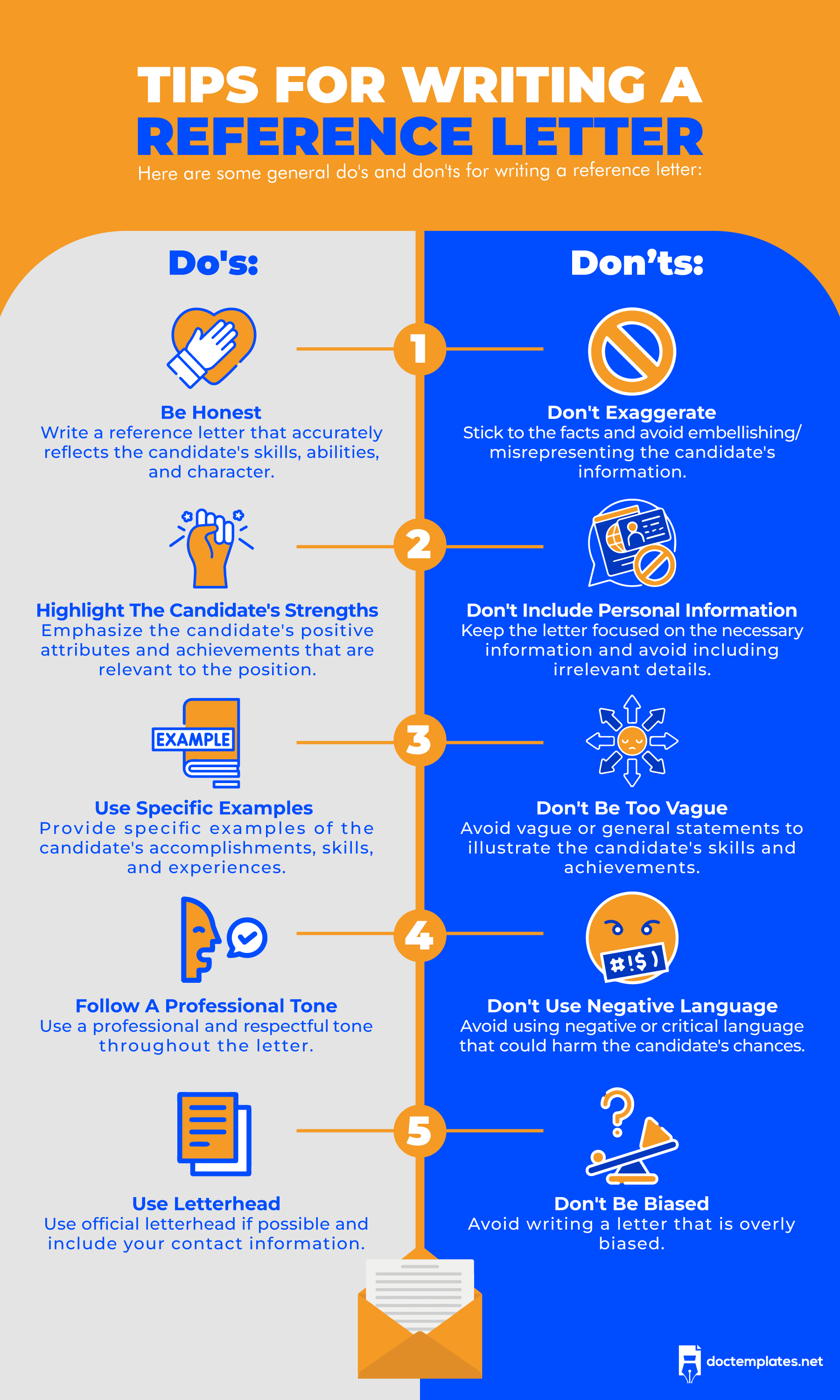
Bottom Line
Reference letters are popular correspondence in most professional fields. They are a means to provide insight as a third party on how an applicant is suited or qualified for a particular position or opportunity. Such a letter should be written in a professional format and tone. Always ensure you are familiar with the person you recommend to provide a strong recommendation.
When crafting a reference letter, you should use business-formatted letter templates and review samples. This can greatly reduce the workload of formatting and determining what information to include in the recommendation.
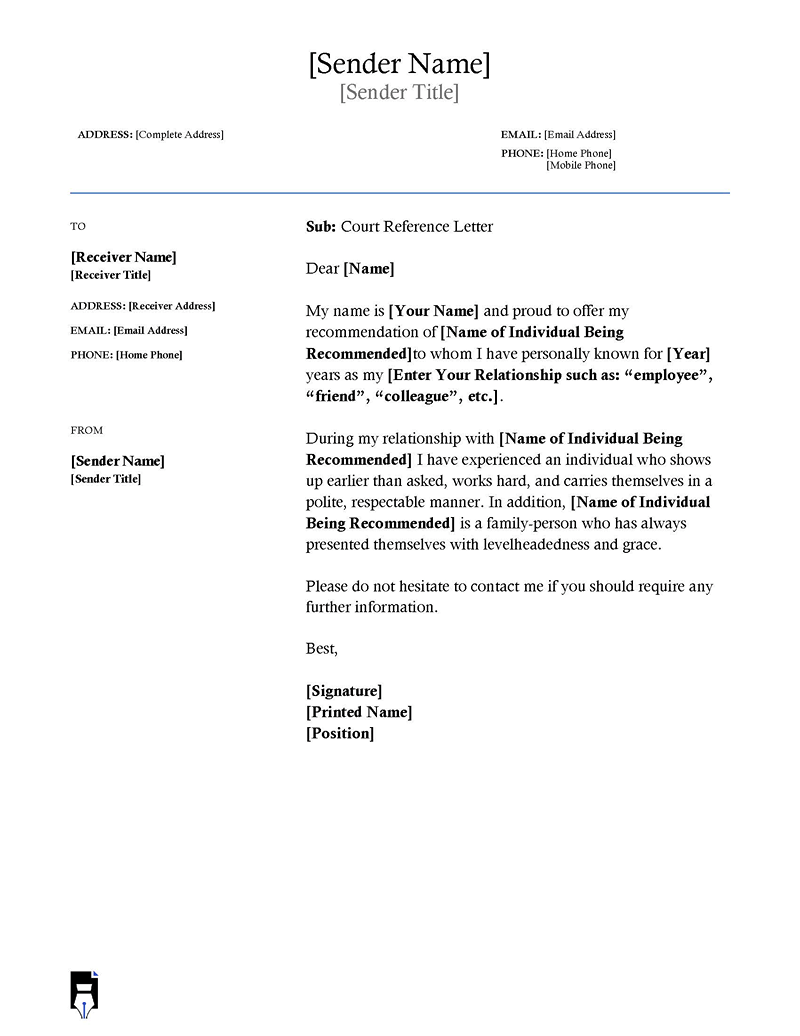
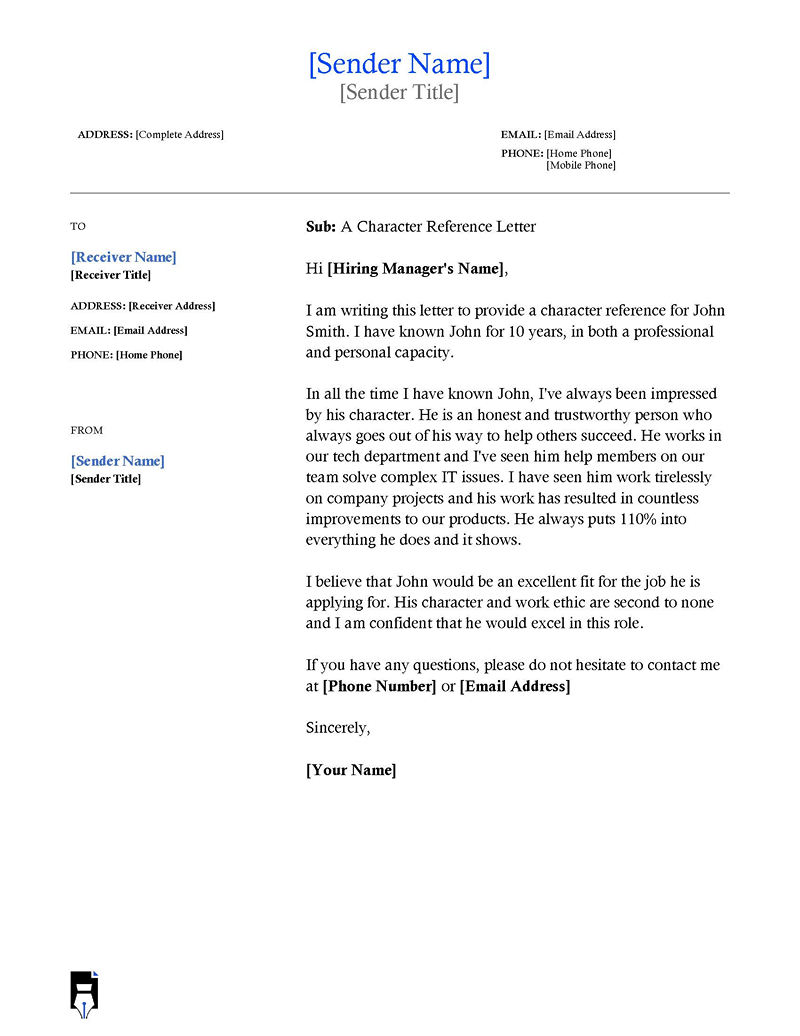
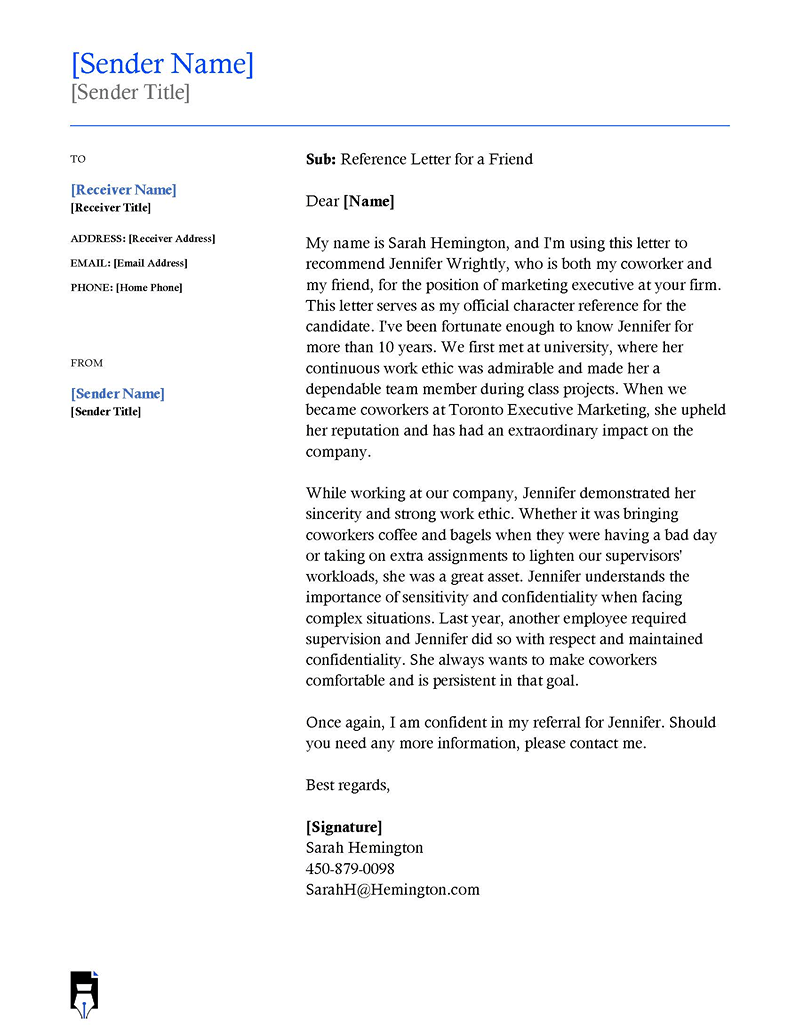
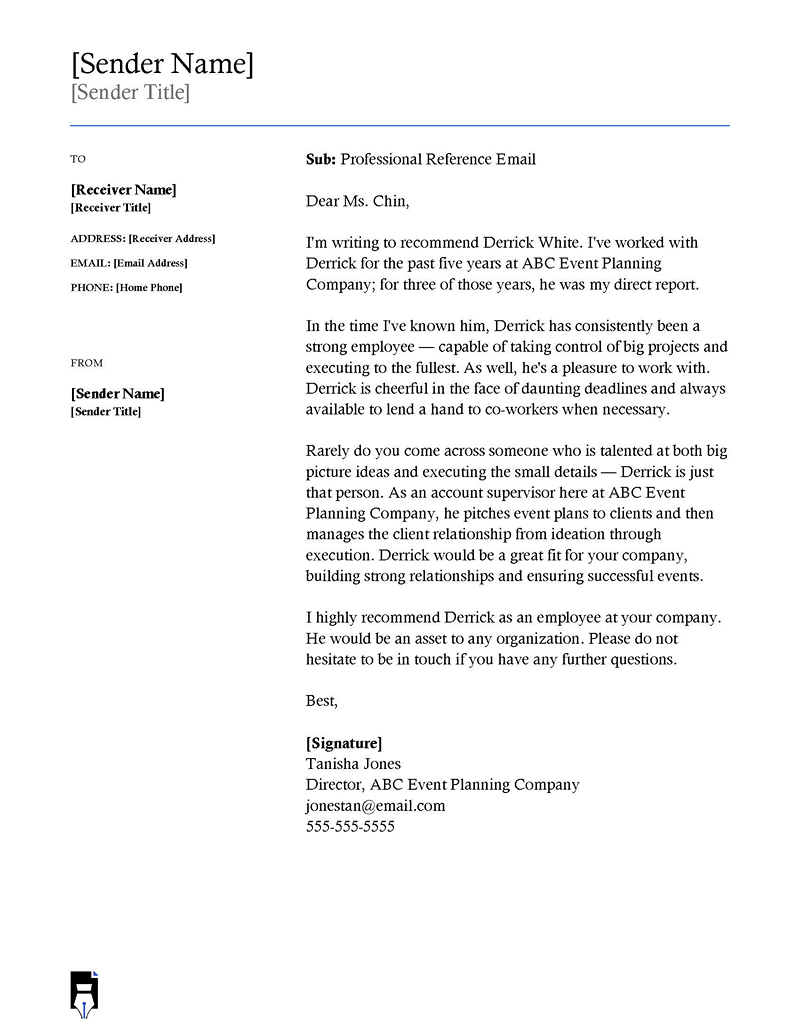
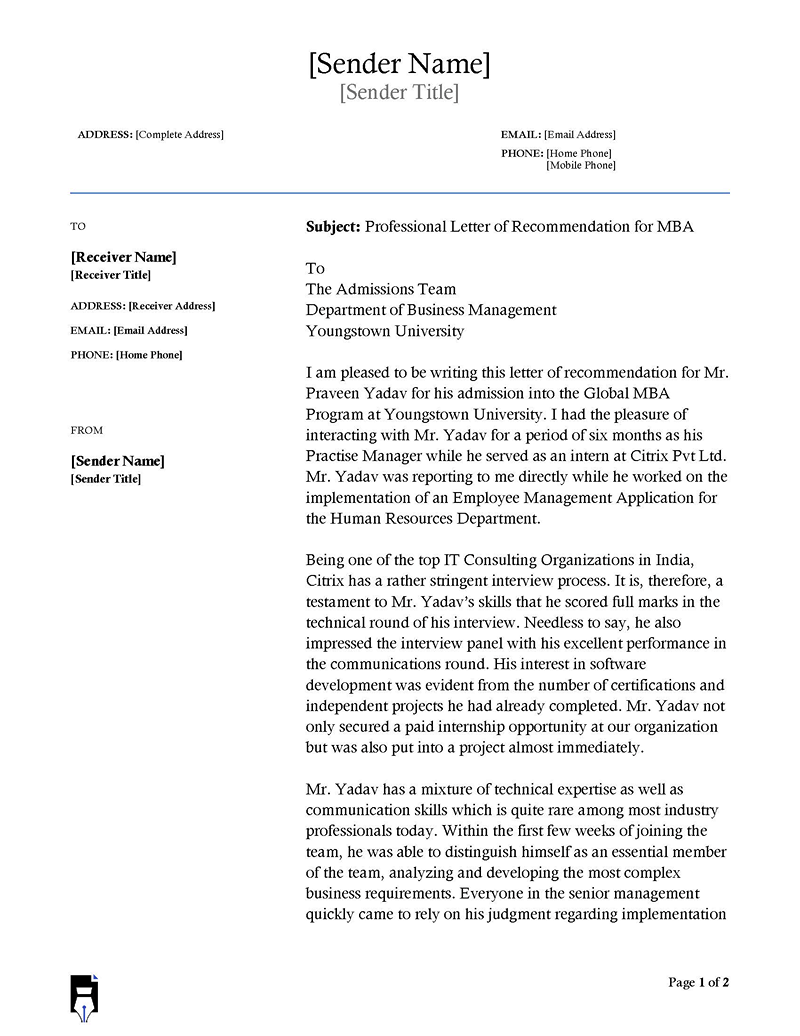
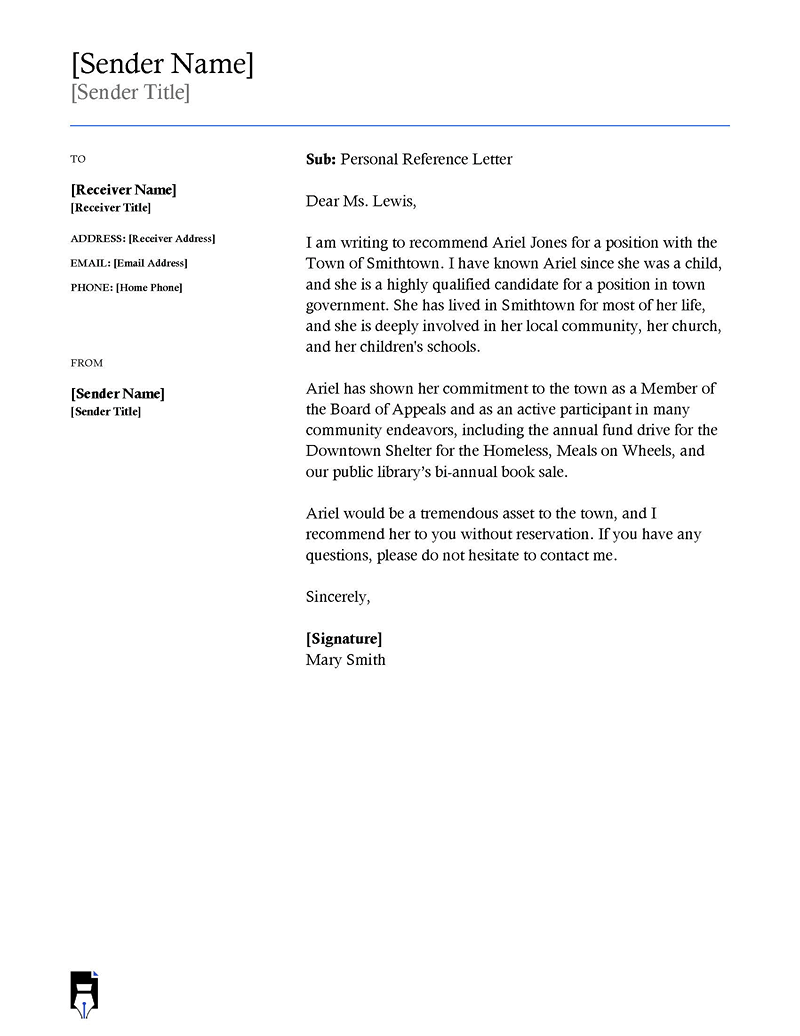
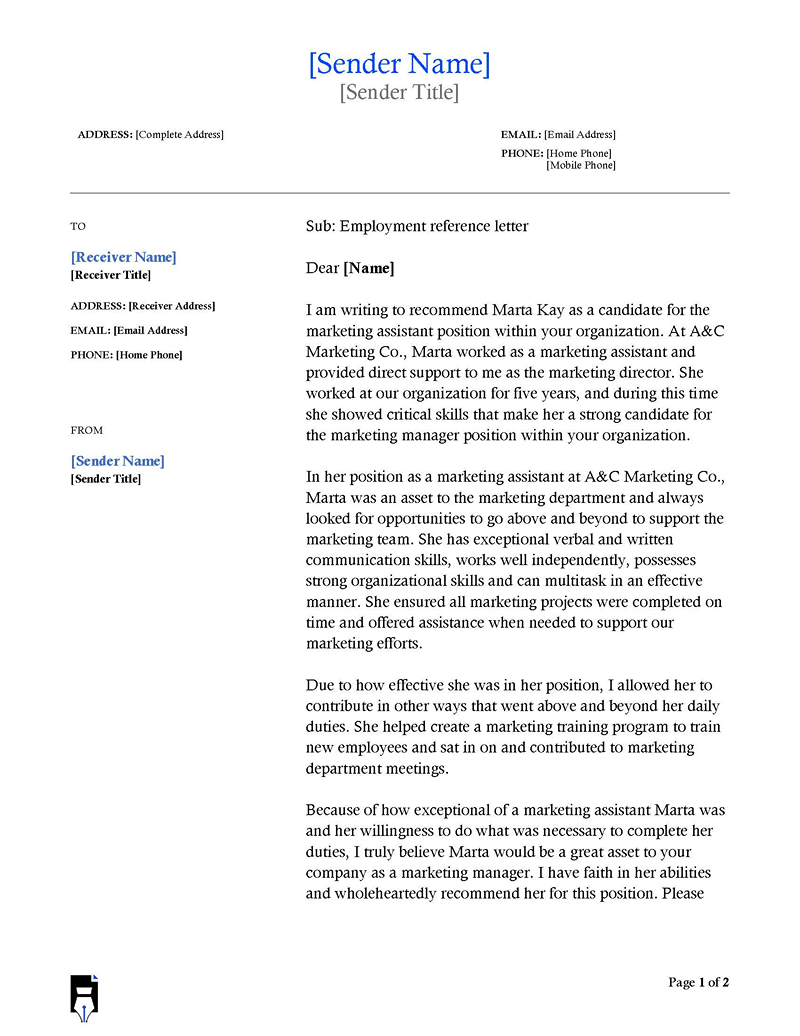
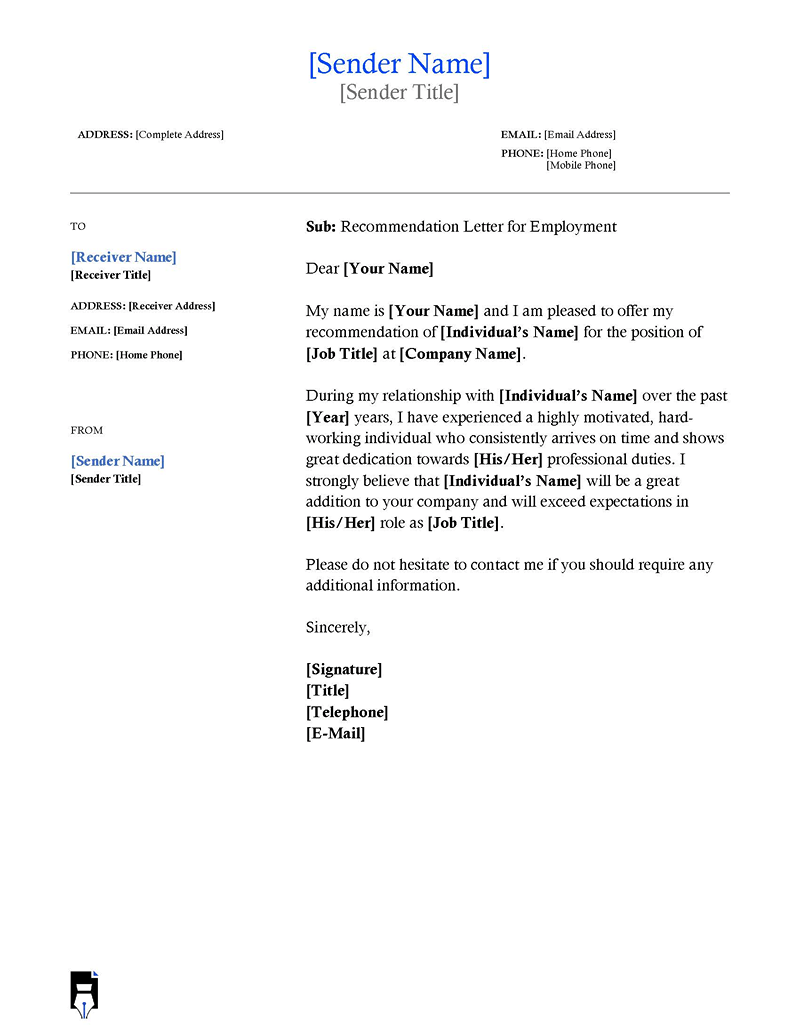
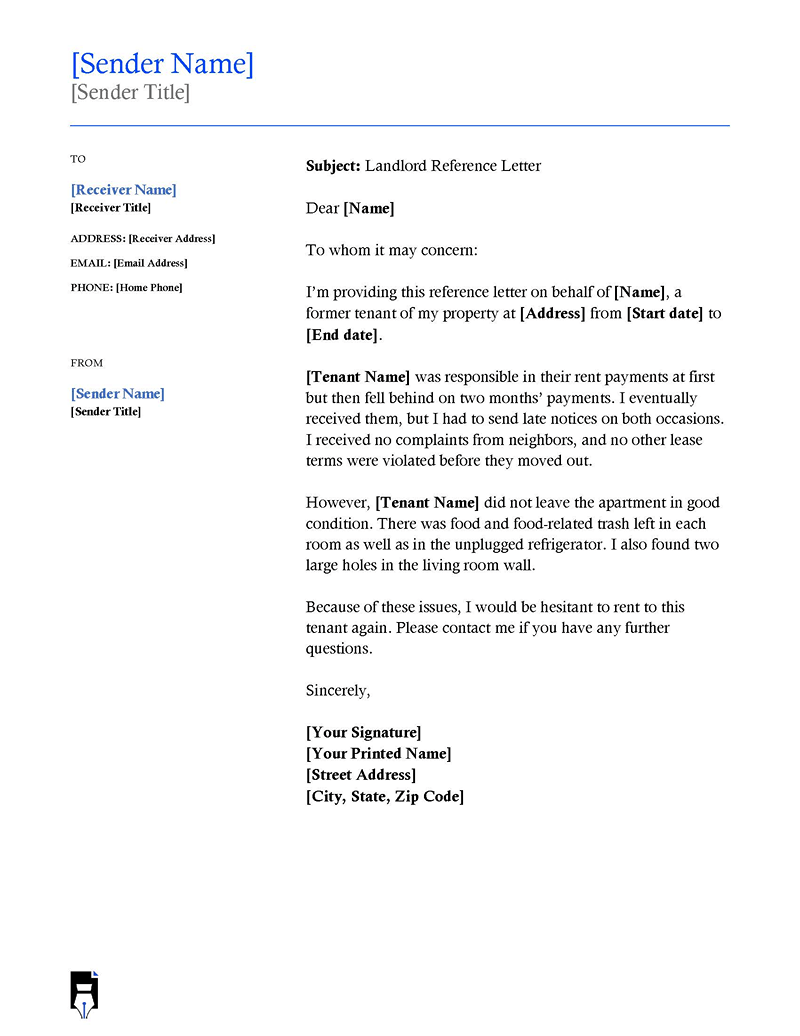
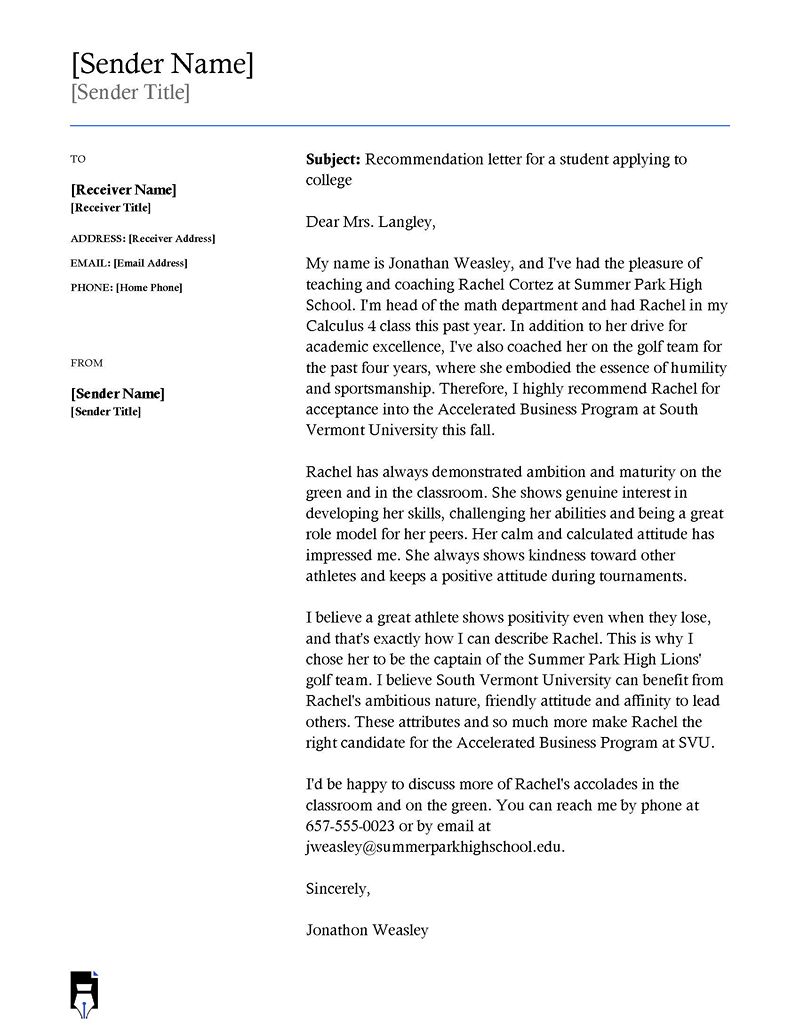
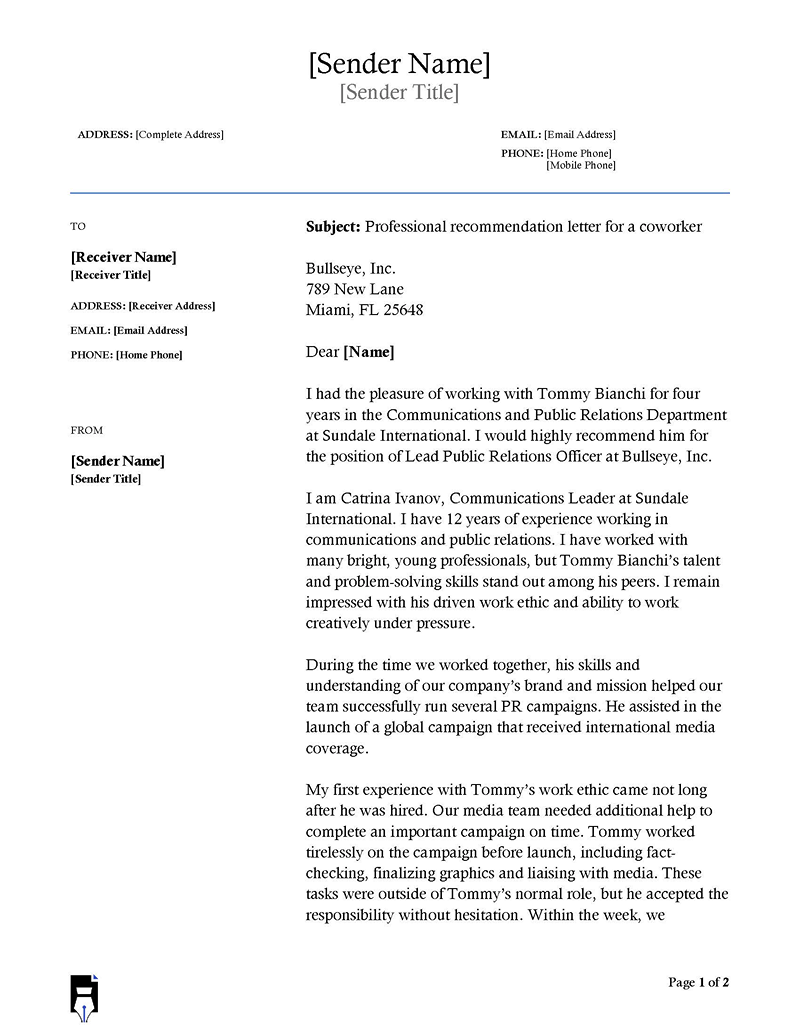
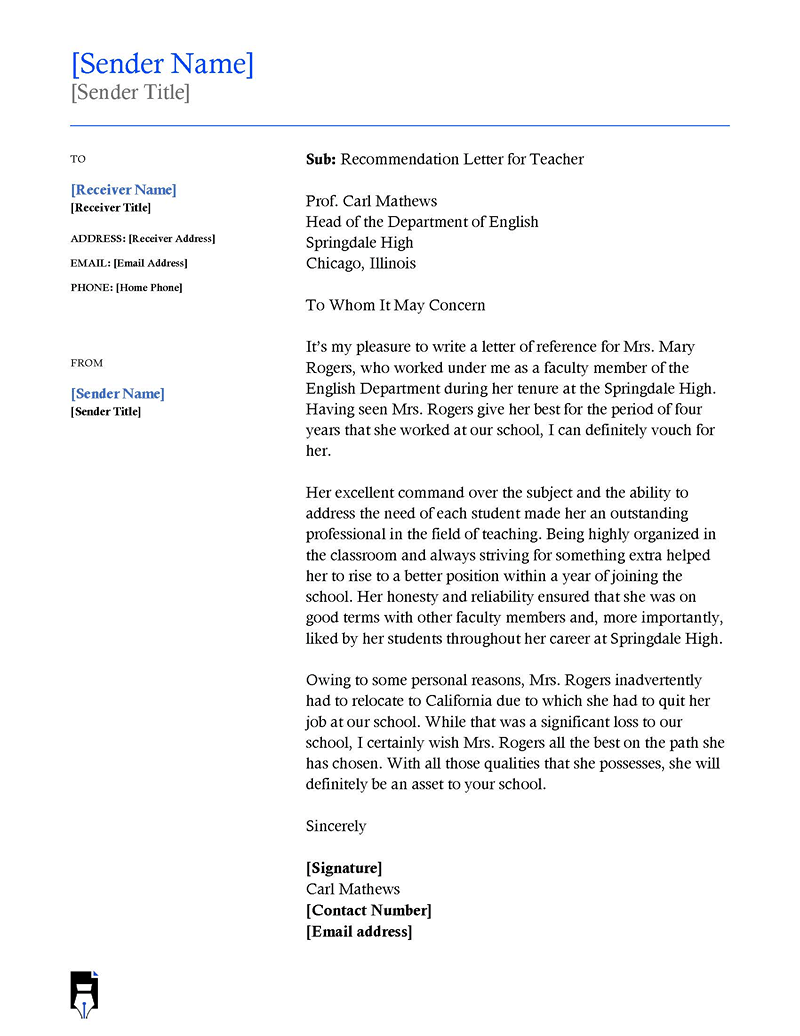
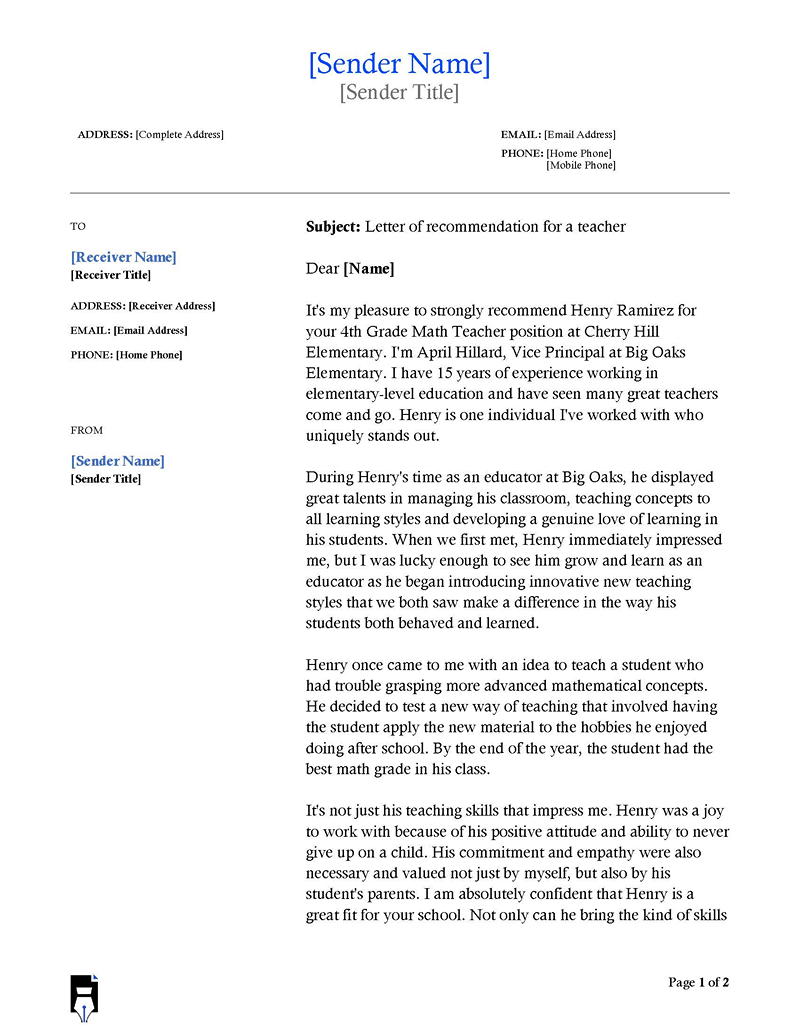
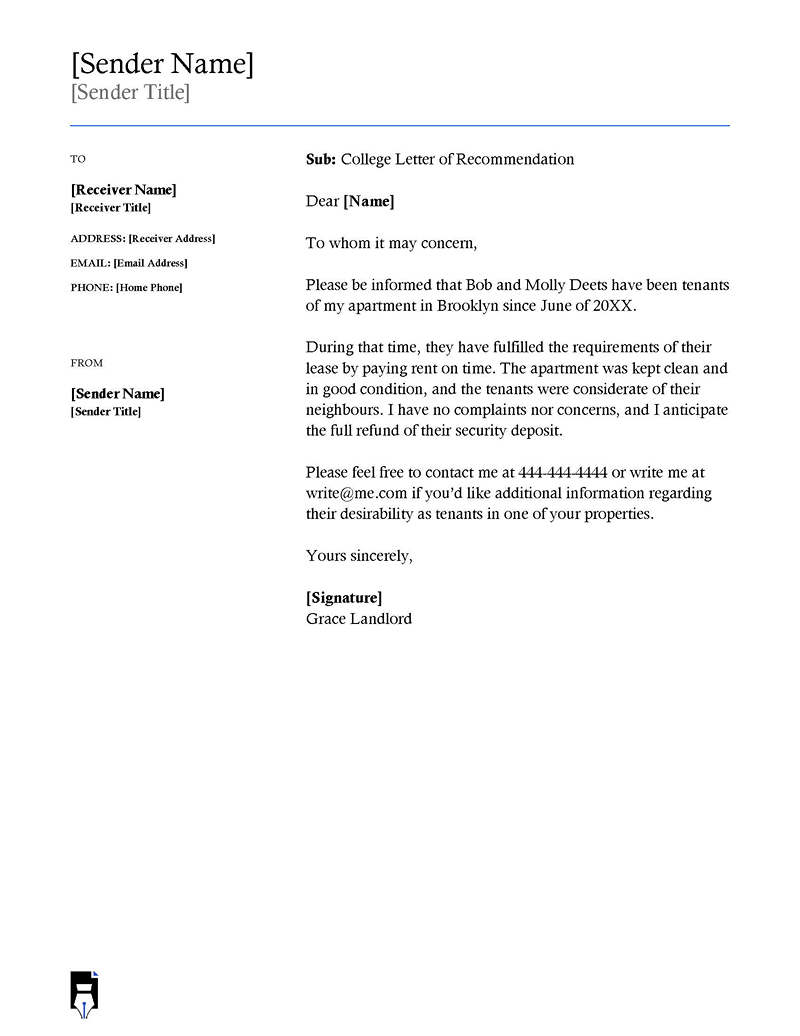
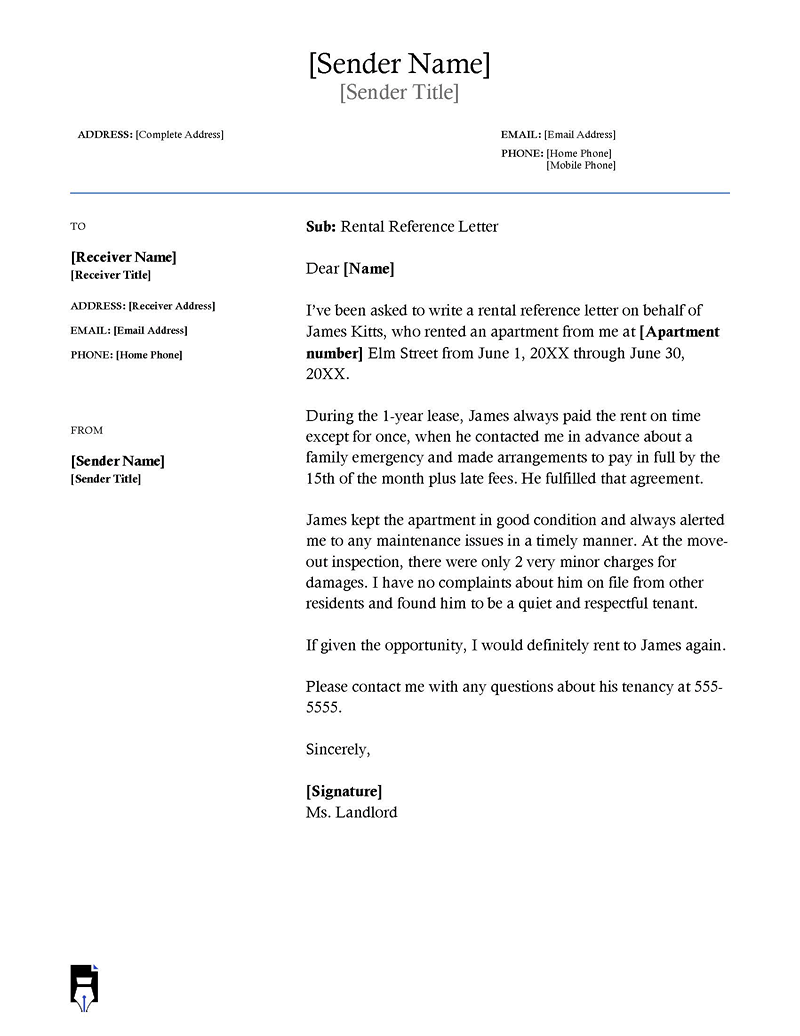
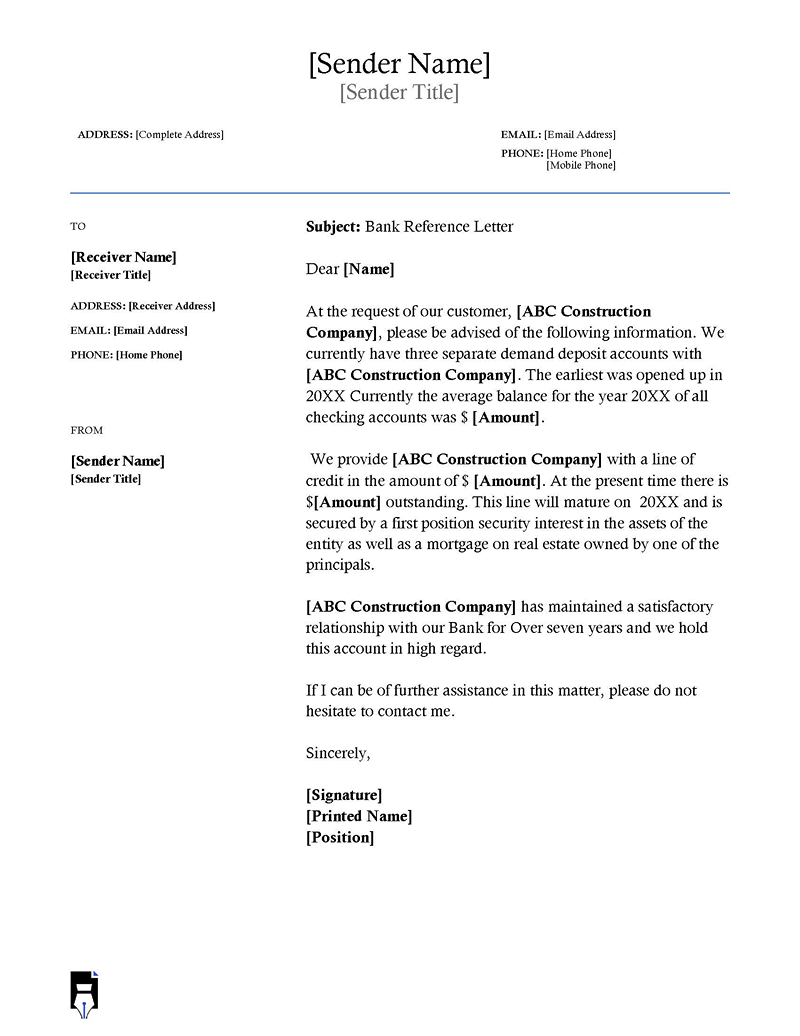
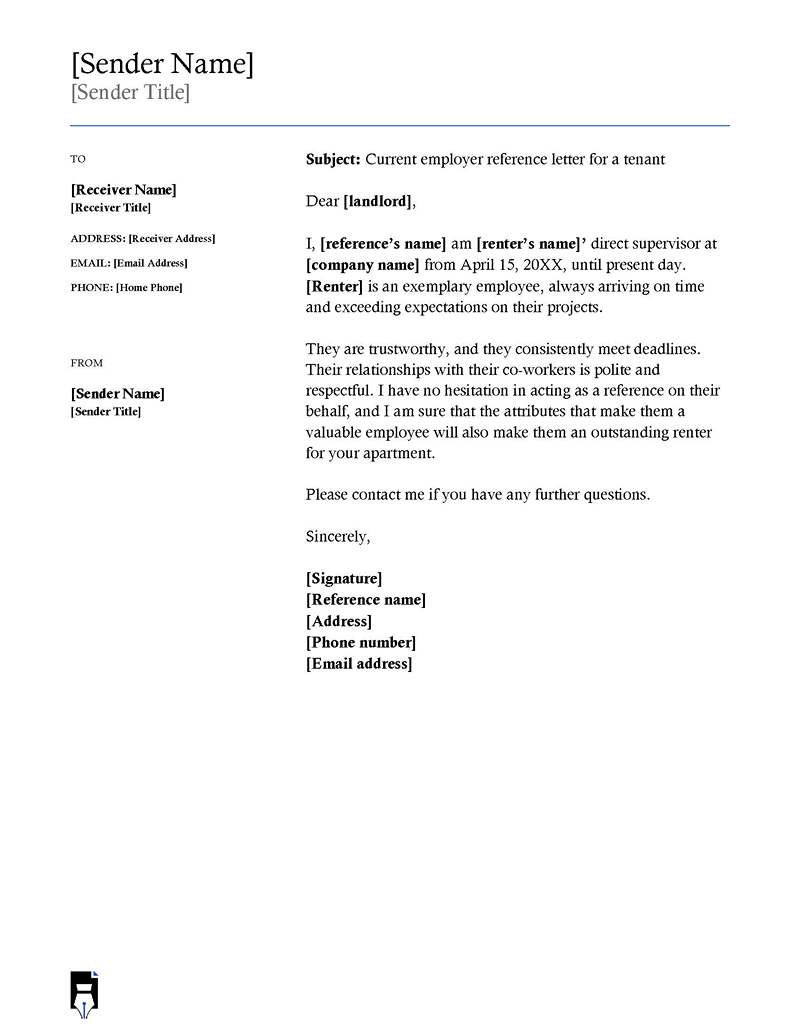
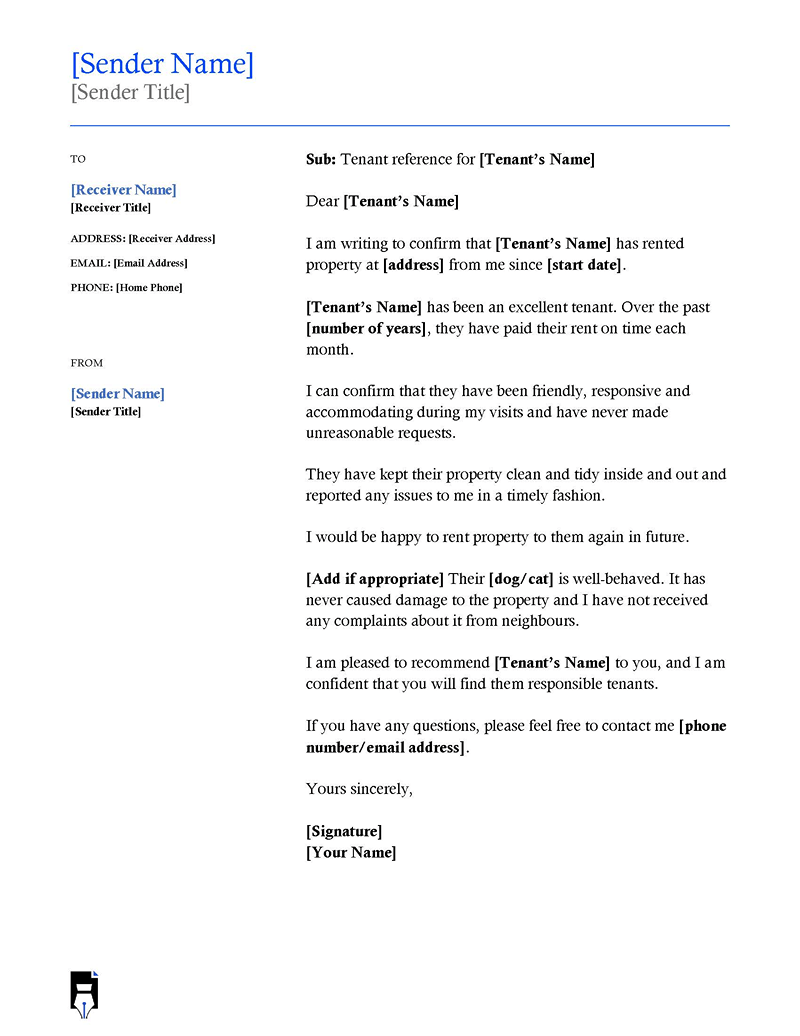 -
-